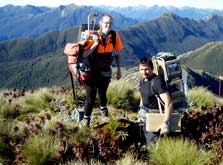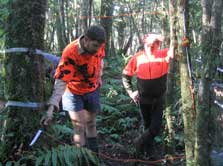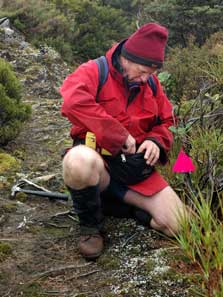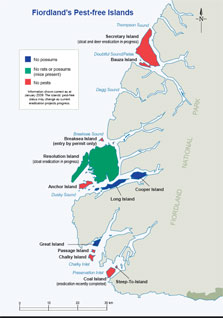Project implementation
Introduction
Implementation of the Fiordland Islands programme follows DOC best practice.
Laying stoat trap tunnels
Restoration of these islands is largely focused on pest eradication and the subsequent translocation of threatened fauna. The first step is to establish a track network across each island in order to lay out stoat traps and improve access for hunting deer. Trapping techniques have been developed since the first stoat eradication was conducted on Te Kakahu / Chalky Island in 1999.
Stoat eradication
The most recent programme on Resolution Island has used stainless steel DOC 150™ kill traps as single-sets in a combination of wooden and wire tunnels. Over 2300 trap tunnels were laid out across a 200 km track network, yielding a density of one tunnel per 9 ha across the island. Traps were baited with a single hen’s egg and meat bait. A pre-baiting programme was undertaken before trapping commenced in mid-winter, when alternative food supplies for stoats would have been at their lowest.
Deer eradication

Setting up deer collar on Anchor
Island
Techniques for deer eradication are still being developed, but are largely based on a combination of helicopter- and ground-hunting for the initial knock-down of the population. A variety of additional techniques are used as deer numbers get low, including remote-monitoring of deer capture-pens, and self-attaching radio collars.
Rodent eradication
Rat and mouse eradications are based on techniques that have been developed by DOC through numerous rodent eradications on islands up to 11,000 ha. The mouse eradication operation undertaken on Coal Island (1163 ha) in 2008 was at the time the largest attempted island mouse eradication.
DOC programmes have been managed by permanent staff, often with a team of seasonal staff or contractors. The work has also benefited enormously from the assistance of volunteers. This arrangement has worked well: involving enthusiastic locals has generated a real sense of community ownership about the programme.
Each part of the programme follows DOC best practice. Operational plans are peer-reviewed, staff and volunteers receive appropriate training, and contracts are monitored closely to ensure the required standards are met.

Volunteer marking track
The Fiordland Islands Restoration Programme has been based on developing methods on small islands, and then applying them to larger ones. Another key to its success is that techniques used in the initial knock-down of pests have often remained in place as part of the ongoing monitoring programme. Control on the adjacent mainland for stoats is important in terms of minimising the risk of reinvasion.
Central to the ongoing success of this programme is ensuring that new pests don’t arrive on these islands. DOC’s activities on the islands are carried out in accordance with the Island Biosecurity Plan: Southland Conservancy. The Department also works with local operators to develop their own biosecurity plans for vessels and shore parties.
DOC-managed pest-eradication programmes on islands in Fiordland
- Norway rats (Hawea Island, 8 ha, 1986; Breaksea Island, 170 ha, 1988)
- Stoats (Te Kakahu/Chalky Island, 514 ha, 1999; Passage Islands, 189 ha, 1999; Anchor Island, 1130 ha, 2001; Bauza Island, 480 ha, 2002; Pigeon and Parrot Islands, 126 ha, 2005)
- Red deer (Anchor Island 2002-05)

Map of Fiordland's pest-free islands
(view larger JPG, 74K)
Major programmes underway include eradicating stoats and deer from 8140 ha Secretary Island (initiated in 2005 and 2007 respectively), and eradicating stoats from 20,860 ha Resolution Island (initiated in 2008).
Community-led pest-eradication programmes on islands in Fiordland
- Stoats (Coal Island, 1163 ha, 2005; Pomona Island, 262 ha, 2006; Rona Island, 60 ha, 2006)
- Red deer (Pomona Island 2006-07; initiated on Coal Island in 2006)
- Mice (Rona Island 2006; Pomona Island 2007; Coal Island 2008)
- Ship rats (Pomona Island 2007)
- Brushtail possums (Pomona Island 2007)
Bird, insect and lizard transfers to Fiordland Islands
- South Island robin (Breaksea Island 1987; Anchor Island 2002 & 2004; Pigeon Island 2007; Secretary Island 2008)
- Fiordland skink Oligosoma acrinasum (from Wairaki Island to Hawea Island 1988)
- Knobbled weevil Hadramphus stilbocarpae (from Outer Gilbert Island III to Breaksea Island 1991)
- Flax weevil Anagotus fairburni (from Wairaki Island to Breaksea Island 1991)
- Tieke/South Island saddleback (Breaksea Island 1992; Passage Islands 2001; Anchor Island 2002 & 2004; Bauza Island 2003; Te Kakahu/Chalky Island 2008)
- Mohua/yellowhead (Breaksea Island 1995; Te Kakahu/Chalky Island 2002; Anchor Island 2002; Pigeon Island 2007; Secretary Island 2008)
- Kakapo (Te Kakahu/Chalky Island 2002 & 2005; Anchor Island 2005)
- Rock wren (Anchor Island 2005; Secretary Island 2008 & 2009)
- Orange-fronted parakeet (Te Kakahu/Chalky Island 2006 & 2007)
- North Island kokako (Secretary Island 2008)
- Little spotted kiwi (Te Kakahu/Chalky Island 2008 & 2009)
- Takahe (Secretary Island 2009)
Tieke and mohua

Releasing mohua
Tieke/South Island saddlebacks were rescued from their last outpost on Taukihepa/Big South Cape Island off Stewart Island following invasion of ship rats in the early 1960s. Following a series of translocations to small islands off Stewart Island, tieke were translocated from Big and Kundy Islands to Breaksea Island (in Fiordland) in 1992. From Breaksea Island, tieke have been translocated to Passage Island, Anchor Island, Bauza Island, and Te Kakahu/Chalky Island.
Similarly, mohua translocated to Breaksea Island from the Blue Mountains in 1995 have subsequently been translocated to Te Kakahu/Chalky Island, Anchor Island, and Pigeon Island. However, the mohua moved to Secretary Island came from the Dart Valley.
